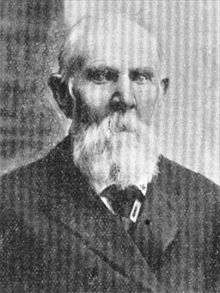Philip DeLaMare
Philip DeLaMare (alternately De La Mare; Delamare in French) (April 3, 1823[1] – October 16, 1915)[2] was a convert to Mormonism who was a key figure in the attempts to introduce the sugar beet industry to Utah in the late-19th century. The modern neighborhood Sugar House, Salt Lake City is named for that trial sugar factory.
| Philip DeLaMare | |
|---|---|
 | |
| Personal details | |
| Born | April 3, 1823[1] Isle of Jersey, England |
| Died | October 16, 1915 (aged 92)[2] Tooele, Utah, United States |
| Cause of death | Senility[2] |
| Resting place | Tooele City Cemetery 40.5237°N 112.2955°W |
| Spouse(s) | Mary Parkin Mary Chevalier Jeanette Mickeljohn[1] |
| Children | 21[1] |
| Parents | Francis DeLaMare Jane Esther Hier |
Early life
DeLaMare was born on the Isle of Jersey in 1823.[3] His parents were Francis DeLaMare and Jane Esther Hier.[4]
Role in founding the Sugarhouse area
DeLaMare converted to The Church of Jesus Christ of Latter-day Saints (LDS Church) in 1849.[4] In 1851, while on a mission to France, DeLaMare accompanied apostle John Taylor to Arras. Arras was home to extensive beet sugar plants and DeLaMare was able to carefully study the industry and evaluate whether or not this business would work well in Utah.[4][5] Taylor and DeLaMare, along with others, purchased beet sugar manufacturing supplies and imported it to America.[4]
The Philip DeLaMare Company
The sugar factory machinery was first shipped from Liverpool to St. Louis then the equipment had to be taken to Utah by wagon.[6] This was the first beet sugar machinery ever brought to America.[3] The company, known as the Philip De La Mare Company, left for Utah Territory on July 4, 1852 with over 80 people. They would arrive on November 10, 1852.[7] DeLaMare led 52 teams of oxen that hauled the equipment to Salt Lake City.[3] Some of these wagons would break down during the journey due to the heavy weight of equipment.[4] The company also had trouble with their cattle dying and more cattle had to be brought in along the way. It is believed that parts of the intricate machinery were lost during this journey, which would later lead to problems in the factory’s attempts to produce sugar.[8]
The Sugar House Sugar Factory
On March 5, 1853, Brigham Young, Heber C. Kimball, John Taylor, Mr. Mollenhauer, Daniel H. Wells, and Amasa M. Lyman selected the southeast corner of 21st South and Highland Drive as the location for the sugar factory. This is in the part of Salt Lake City now known as "Sugar House".[3][4]
Seeds were sent ahead and about 300 acres of land were planted with sugar beets.[4][9] The factory began operating in February 1855.[3] The finished factory used a water wheel in Parley’s Creek to power the factory.[8] By the end of the summer in 1855, Brigham Young concluded the factory to be a failure and ordered it to be shut down.[3][9] The factory could not produce sugar, and would only ever create molasses.[8]
There are several theories as to why the factory could not produce sugar. It appears some parts of the factory machinery may have been lost on the journey to Utah. In the Agricultural History journal, historian Leonard Arrington theorized that the problems was with the chemical nature of the beets made them difficult to convert since they were grown in alkali soil.[8] Another historian believed the salt content of the beets was much higher than the content of those grown in France and that this imbalance caused the problem.[8] Others have speculated that the Sugar House factory was never able to master the crystallization method necessary for the process.[8] It is believed that approximately $100,000 was spent in the attempt to make sugar production successful at the factory.[9]
The factory was later used as a paper mill (which processed sunflower seeds, weeds, straw, and old rags), roundhouse, bucket and tub works, woolen factory, a machine shop for the Utah Central Railroad, coal yard office, and weighing station.[3][4][5] The factory was completely torn down in 1928.[5]
References
- Jenson, Andrew (1914). Latter-day Saint biographical encyclopedia: A compilation of biographical sketches of prominent men and women in the Church of Jesus Christ of Latter-Day Saints. 2. Salt Lake City, Utah: The Andrew Jenson History Company (Printed by The Deseret News Press). pp. 286-286. Retrieved November 18, 2013.
- "State of Utah Death Certificate: Philip DeLamare". The State of Utah. Retrieved 18 November 2013.
- "His Name'S Not Recognizable Readily, But He Did A Lot For Sugar Industry". Deseret News. 1989-05-11. Retrieved 2013-09-08.
- "Plaza Monument: It's a Tribute to People, Industry". The Deseret News. 1 May 1974. Retrieved 18 November 2013.
- "Sugar House Salt lake Area's Rich History Full of Historical Firsts". The Deseret News. 17 February 1994. Retrieved 18 November 2013.
- Richard Jensen, "A New Home, A New Life: Contributions of the European Saints in Building the Kingdom", Ensign, August 1973.
- "Philip De La Mare", Pioneer Database 1847–1868, 2020. Retrieved on 24 March 2020.
- "Sweet firsts in Sugar House". Deseret News. 1997-09-19. Retrieved 2013-09-08.
- "History of Sugar House dates back to Pioneers". The Deseret News -. 26 April 1977. Retrieved 18 November 2013.